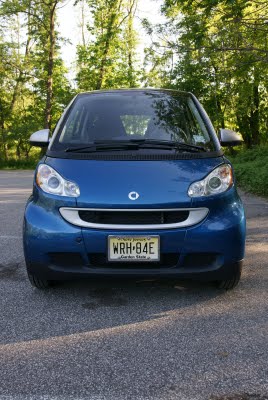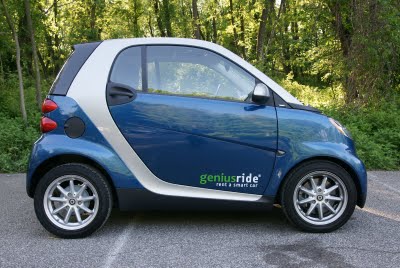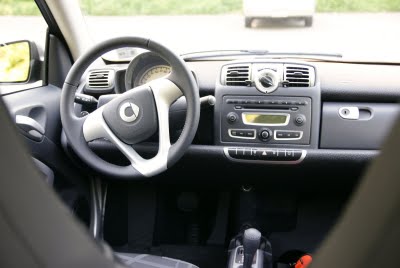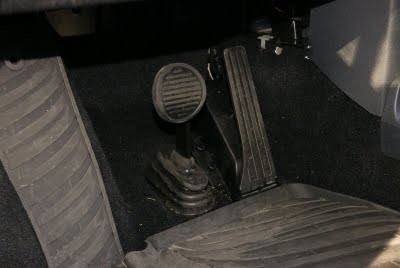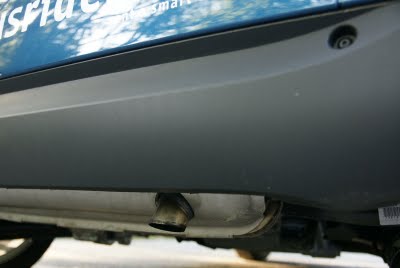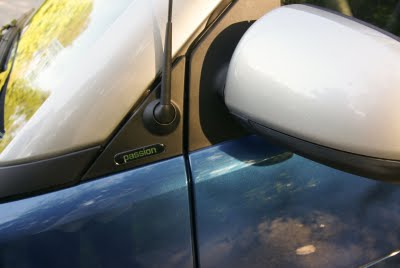The Smart Car Passion Coupe Reviewed
After nearly 10 years, the Smart Car has finally come to the USA (and nearly 4 years after arriving in Canada). I first saw a Smart Car in 2005 when I was in London. In fact, I saw two models - the ForTwo coupe, and the Smart Roadster, which I thought was an outstanding sports car for those on a strict budget (and didn't mind a less than sports car top speed). Sometime between then and now, Smart even introduced a short-lived ForFour sedan, which seemed to be their best product. But it has been the ForTwo coupe that has been the iconic, best-selling model in their lineup since 1998.
In 2006, Smart's parent company, Mercedes-Benz, announced a redesign of the Smart ForTwo coupe, to go on sale in January 2008. While four models of the ForTwo coupe are offered in Germany, the US has received two models - the Pure and the Passion. I was able to rent the Passion for a 28 hour period.
Before I get into all the exciting details, here is a high-level summary:
Pros:
- Ultra-compact, cute, stylish, well-made minicar.
- Fun rear-wheel drive + tight turning radius = great city handling
- An attention-grabber. You'll make lots of friends and have conversations with strangers wherever you go.
- 40MPG overall is achievable if you drive conservatively and shift perfectly.
Cons:
- With hard pedal action and no power steering on most models, driving can be a bit of a workout. Older drivers should steer clear unless they can find one with the power steering option.
- Audio system is high quality. But only two speakers? They need to double that to four!
- Unless you sacrifice some of the precious 10 cubic feet of cargo space, there is no spare tire storage. Smart car expects you to use the tire repair kit, or call for help if you get a flat.
- Highway driving is never a relaxing experience. The car cannot go faster than 80MPH, making passing a rare occurrence. Stay in the right lane and don't stray too far from home.
The Smart car is clearly not for everyone. Stop considering one if you expect to have more than one passenger, carry more than one standard rolling luggage piece and a large duffel bag, do a lot of highway driving, or are not open to the idea of a daily drive being a calorie-burning experience. If you are OK with the criteria above, and are looking for all of that plus the unique ability to park in more places, and make a lot more friends (and possibly envious enemies), read on.
The Smart ForTwo comes in two trim levels, the Pure and the Passion. The Passion is by far the more popular model, and I think the only one worth considering, given the excellent standard features it adds for a modest price increase over the Pure. In fact, given that the Pure doesn't include a radio, it is clear that it is targeted at the food delivery market. The Passion comes standard with quality features including air conditioning, a lexan, transparent roof, paddle shifting, power windows and door locks, heated electric side mirrors, a leather-wrapped 3-spoke steering wheel, a single-disc CD player and radio with axillary audio input jack (in the glove compartment), and very nice, attention-grabbing, 9-spoke 15" alloy wheels with low profile 155/60 tires in the front, and 175/55's in the rear. If you are patient, you can find some Passion models with a 6-disc CD player (my test vehicle did), power steering, fog lamps, additional gauges, and a hard-to-find comfort package, which adds leather heated seats, automatic rain-sensing wipers, and auto-off headlamps (a must for a forgetful guy like me).
As I practiced lifting my foot off the gas at the start of a gear shift, I made the move to be more pro-active. The Smart Car Passion has a tiptronic semi-automatic transmission with steering wheel-mounted paddle shifting. By flicking the floor-mounted gear shift to the left, you engage tiptronic mode. A large gear indicator in the instrument panel shows the current gear as a large LCD numeral, which changes to a big up or down arrow when it is time to execute a shift. Unfortunately, there is no option to accompany the arrow with a audible alert. Of course, I wouldn't need an audible alert if I had a tachometer. But that's an option that was not installed on my car. But I figured it out. If I drove with the radio off and got to listen to all the sounds the car made, I got it to run smoother, accelerate better, and even get into the middle lane of the Major Deegan (I-87) to do some passing.

 Plastics are good for the price, and put Chrysler / Jeep / Dodge to shame. Window and mirror controls are taken directly from a previous Mercedes C-class model.
Plastics are good for the price, and put Chrysler / Jeep / Dodge to shame. Window and mirror controls are taken directly from a previous Mercedes C-class model.
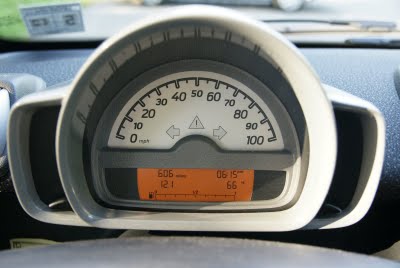 No engine temperature gauge or tachometer here. A pair of sporty, dash-mounted instruments are optional ($130).
No engine temperature gauge or tachometer here. A pair of sporty, dash-mounted instruments are optional ($130).

"Does that run on gas or electric?"
"How fast can that go?"
"Can you take it on the highway? Is it scary on the highway?" (They laughed when I said, "Stay in the right lane.")
"What's the fuel economy?"
The reactions from pedestrians were priceless. I had people pointing, waving, laughing, and running-up to ask me questions. I heard comments like "cool," "smart," and some chatter about gas prices as I drove by with my windows down. In particular I spoke to some Latino youths in Red Hook who spotted me from 50 yards away, and ran into the street to ask me all sorts of questions. One expressed interest in renting it for himself. And another expressed an interest in seeing two Smart cars in a street race.
In Inwood, a guy and his girlfriend pulled-up on my left on a two-way street to tell me that it was "so cute" and that they want to rent it this summer.
In Times Square, I had bunches of people waving and giving me a thumbs-ups I slowly rolled around Wednesday at midnight. However, two big, seemingly drunk men on West 42nd Street weren't so happy to see me. They crossed 42nd Street in between 10th and 9th avenues to take swipes at the car as I sped past. One of them slapped my right side mirror into its folded position, but thankfully didn't leave a mark. I can only assume that was a rare occurrence, but a unique car attracts unique responses.
The USA version of the ForTwo is powered by a Mitsubishi 3B2 engine, the same aluminum block engine that powers Mitsubishi's successful 5-door minicar, the "i". However, the heavier Mitsubishi vehicle is powered by a turbocharged version of that engine. In the Smart ForTwo, the 1-liter, naturally-aspirated 3-cylinder engine generates a modest 71 horsepower.
While the engine does not rev any higher than a comparable 16-valve 4-cylinder, the heat generated by the engine can be felt in the cargo area after an hour of driving or so. It was warm enough to gently heat my groceries during a late-night run to the Fairway supermarket in Red Hook. I wouldn't advise putting milk or ice cream in the cargo area for more than an hour of driving. At the very least, get an insulated cargo tote, since items in the cargo area will bounce around, even during gentle driving around town. When I went to the rear hatch to retrieve my groceries, I noticed something else. Because the hatch is directly above the tailpipe, I got a whiff of both engine heat and exhaust. It smells a lot like a motorcycle...or lawn mower. Not a danger, but something I am not used to in a regular-sized combustion-powered automobile.
Thursday morning at 05:00, the car was where I left it, undisturbed. I did what I intended to do with the car in the first place. I rented it so I could pick-up my girl from JFK and take her out for breakfast and a drive. I took it to my local car wash. As the workers there laughed and giggled, I rode through the car wash and most of the brushes made contact with the rear window of the car. So it passed the car wash test. Just be sure to remove the radio antenna before going through.
As I completed a tight parallel parking maneuver in front of my building, my girl asked, "Where's the spare tire stored?" I replied that the car didn't have a spare on-board. We agreed that was a big sticky point. Probably a deal-breaker.
Apparently there is a 12-month wait list for the Smart ForTwo at Smart Car of Manhattan. Geniusride, which is based out of the Englewood Mercedes dealership, says that they can import a Smart ForTwo in a matter of days at the sticker price ($14,000 for the Passion, about $14,500 for the model I drove with the 6-disc CD player). Geniusride is a car rental company for the Internet era. They accept payments via PayPal and soon they will have an online reservation system.
At $80 a day ($90 on weekend days), a SmartCar rental is the best way to test drive the ForTwo. You have to spend a full day with the car to master the handling and driving techniques.
A rental is worth the fun and discovery. But a purchase? You would have to weigh the pros and cons carefully, as well as check out these larger vehicles. While none of them can match the ForTwo's 35-40MPG overall fuel economy, all of them are priced at or under $15,000, carry more cargo, and carry a spare tire. They include:
- Chevy Aveo 5-door ($13,000)
- Ford Focus 4-door (Base) ($15,000)
- Hyundai Elantra GLS 4-door ($14,000)
- Kia Spectra 4-door ($14,000)
- Honda Fit (Base) 5-door ($14,000)
- Scion xD 5-door ($14,000 with no option packages)
- Suzuki SX4 AWD (Base) 5-door ($15,000)
- Toyota Yaris-S 3-door ($15,000; $12,000 for the Yars base model)
- Toyota Matrix 5-door ($15,000 with no options)
Like the late 1970s, we are seeing an increase in the number of small cars on the market. Japan keeps the most beautiful specimens in its home market. But that might change. More American consumers have to do what European consumers have had to do with rising fuel prices, and that is embrace the hatchback. As the price of gasoline is expected to rise indefinitely to $4 and $5 per gallon and beyond, we should see more sleek, fuel-sipping hatchbacks. The Smart is about as small as a combustion-powered hatchback can get. In order for it to feel at home, a lot of people will have to buy it. In environmentally-conscious Manhattan, that won't be a problem. But we may never see European hatchbacks in Indiana.
Then again, considering this morning's news from GM, we might see more tiny GM hatchbacks like the Chevy Aveo. Hummer might be finished as a mass market brand. This is big news.
In some respects, the Smart ForTwo is a preview of cars to come. Manual controls and a minimum of electronics all contribute to a lighter car that saves energy. Today's electric cars have similar characteristics, such as a lack of power steering. My first car could conceivably be an electric hatchback. Instead of lamenting the loss of luxury car conveniences, I should look at the Smart as a training vehicle for the electrics that will hopefully come to market.
